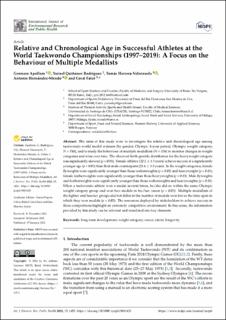| dc.contributor.author | Apollaro, Gennaro | |
| dc.contributor.author | Quiñones-Rodríguez, Yarisel | |
| dc.contributor.author | Herrera-Valenzuela, Tomás | |
| dc.contributor.author | Hernandéz-Mendo, Antonio | |
| dc.contributor.author | Falco, Coral | |
| dc.date.accessioned | 2022-09-08T07:41:26Z | |
| dc.date.available | 2022-09-08T07:41:26Z | |
| dc.date.created | 2022-01-31T17:34:10Z | |
| dc.date.issued | 2022 | |
| dc.identifier.citation | Apollaro, G., Rodríguez, Y. Q., Herrera-Valenzuela, T., Hernández-Mendo, A., & Falcó, C. (2022). Relative and chronological age in successful athletes at the world taekwondo championships (1997–2019): A focus on the behaviour of multiple medallists. International Journal of Environmental Research and Public Health, 19(3). | en_US |
| dc.identifier.issn | 1661-7827 | |
| dc.identifier.uri | https://hdl.handle.net/11250/3016472 | |
| dc.description.abstract | The aims of this study were to investigate the relative and chronological age among taekwondo world medal winners (by gender, Olympic 4-year period, Olympic weight category; N = 740), and to study the behaviour of multiple medallists (N = 156) to monitor changes in weight categories and wins over time. The observed birth quartile distribution for the heavyweight category was significantly skewed (p = 0.01). Female athletes (22.2 ± 3.5 years) achieve success at a significantly younger age (p = 0.01) than their male counterparts (23.6 ± 3.3 years). In the weight categories, female flyweights were significantly younger than those welterweights (p = 0.03) and heavyweight (p = 0.01); female featherweights were significantly younger than those heavyweights (p = 0.03). Male flyweights and featherweights were significantly younger than those welterweights and heavyweights (p = 0.01). When a taekwondo athlete won a medal several times, he/she did so within the same Olympic weight category group and won two medals in his/her career (p = 0.01). Multiple medallists of the lighter and heavier groups did not differ in the number of medals won but in the time span in which they won medals (p = 0.02). The resources deployed by stakeholders to achieve success in these competitions highlight an extremely competitive environment. In this sense, the information provided by this study can be relevant and translated into key elements. | en_US |
| dc.language.iso | eng | en_US |
| dc.publisher | MDPI | en_US |
| dc.rights | Navngivelse 4.0 Internasjonal | * |
| dc.rights.uri | http://creativecommons.org/licenses/by/4.0/deed.no | * |
| dc.subject | long-term development | en_US |
| dc.subject | weight category | en_US |
| dc.subject | career | en_US |
| dc.subject | talent | en_US |
| dc.subject | longevity | en_US |
| dc.title | Relative and Chronological Age in Successful Athletes at the World Taekwondo Championships (1997–2019): A Focus on the Behaviour of Multiple Medallists | en_US |
| dc.type | Peer reviewed | en_US |
| dc.type | Journal article | en_US |
| dc.description.version | publishedVersion | en_US |
| dc.rights.holder | © 2022 by the authors | en_US |
| dc.source.volume | 19 | en_US |
| dc.source.journal | International Journal of Environmental Research and Public Health (IJERPH) | en_US |
| dc.source.issue | 3 | en_US |
| dc.identifier.doi | 10.3390/ijerph19031425 | |
| dc.identifier.cristin | 1995456 | |
| cristin.ispublished | true | |
| cristin.fulltext | original | |
| cristin.qualitycode | 1 | |

